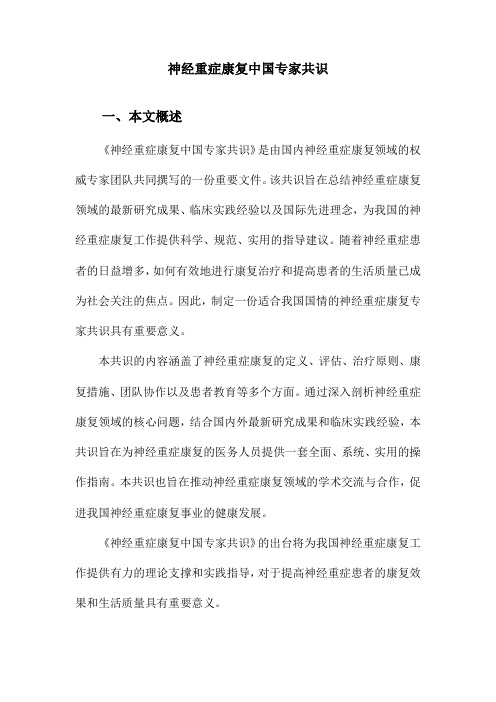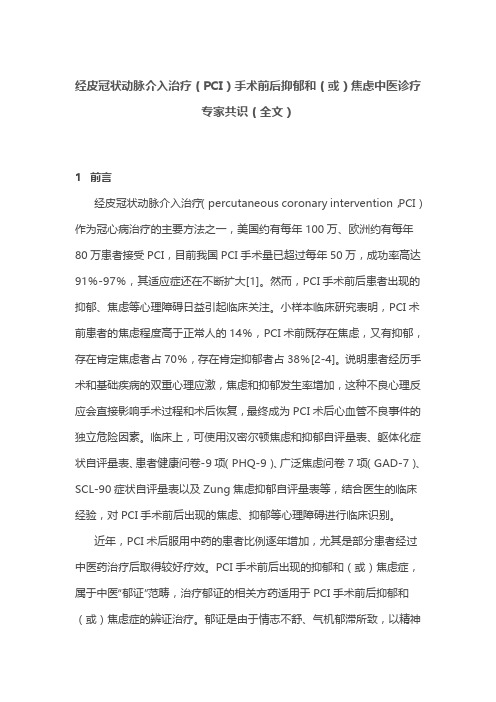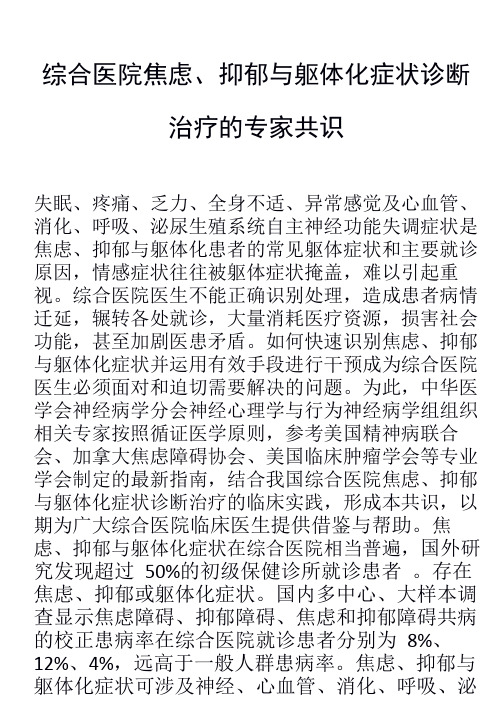神经系统疾病伴发抑郁焦虑障碍的诊断治疗专家共识
《中国成人失眠伴抑郁焦虑诊治专家共识》(2020)要点

《中国成人失眠伴抑郁焦虑诊治专家共识》(2020)要点随着生活节奏的加快,失眠和抑郁、焦虑的发生率日趋升高。
失眠是最常见的睡眠障碍之一,长期失眠不仅会降低生活质量、影响社会功能,还会引发一系列躯体和精神疾病,如心脑血管疾病、代谢性疾病、肿瘤等。
失眠是抑郁障碍独立的危险因素。
失眠与焦虑存在共同的病理生理机制且易于“共病”,在治疗上也应重视“同治”的原则。
失眠和抑郁、焦虑既可以独立发生,也可以相伴存在,在症状学和疾病的层面密不可分。
失眠伴抑郁、焦虑在临床表现、治疗和预后方面与单纯失眠有很大差别,且预后更差、危害更严重,需要高度重视及积极处理。
概述一、失眠与抑郁、焦虑的定义(一)失眠的定义临床上常使用的失眠概念包括“失眠症状”“失眠障碍”(或失眠症)。
“失眠症状”是指患者对睡眠时间和(或)质量不满意,包括入睡困难、睡眠维持困难或晨间早醒等。
“失眠障碍”是指失眠症状达到了疾病的诊断标准,并引起具有临床意义的痛苦,导致社交、职业、学业或其他重要功能的损害,且不能解释为其他睡眠障碍、精神障碍、躯体疾病及物质滥用所造成的效应。
根据《国际疾病分类》第11版(ICD-11),失眠障碍分为3类:慢性失眠障碍、短期失眠障碍和未分类的睡眠减少。
本共识中的“失眠”特指“失眠障碍”。
(二)抑郁的定义临床上常使用的抑郁概念包括“抑郁情绪”“抑郁状态”和“抑郁障碍”。
“抑郁情绪”可以是一种正常的生理过程,持续时间短,不需要医学处理。
“抑郁状态”是一组以显著的抑郁心境为主要特征的综合征,往往表现为病理性情绪、行为和躯体化症状,持续时间较生理性抑郁情绪略长,需要医学处理。
“抑郁障碍”即精神医学中所指的“抑郁症”,是指由各种原因引起、以显著而持久的心境低落为主要特征的一类心境障碍,持续时间超过2周,对患者社会功能有显著影响,达到临床诊断标准,需给予积极治疗。
抑郁障碍的诊断标准主要参考《精神障碍诊断与统计手册第5版》(DSM-5)。
本共识中的“抑郁”包括“抑郁状态”和“抑郁障碍”。
神经系统常见疾病伴发抑郁焦虑障碍的诊断 精品

诊断步骤:
初查、识别
量表应用和 疾病诊断
常见神经系统疾病 伴发抑郁的诊断
神经系统疾病伴发抑郁焦虑障碍诊治专家共识组.中华内科杂志.2011;50(9):1-7
初查与识别
• 询问神经系统疾病表现
• 着重询、注意力、自卑和自责 轻生观念 • 以筛查抑郁综合征
神经系统疾病伴发抑郁焦虑障碍诊治专家共识组.中华内科杂志.2011;50(9):1-7
“90秒钟4问题提问法”诊断敏感率达96%
90秒钟4问题提问法
过去几周(几个月)你是否感到无精打采、 伤感、或对生活的乐趣减少? 除了不开心之外,是否比平时更加悲观 或想哭 你经常有早醒么(事实上你并不需要那么 早醒来)? 你进来是否经常想到活着没意思?
“是”为阳性
“是”为阳性
每月超过1次为阳性 “经常”或“是”为阳性
神经系统疾病伴发抑郁焦虑障碍诊治专家共识组.中华内科杂志.2011;50(9):1-7
常见神经系统疾病伴发抑郁障碍的诊断
疾病 MS AD PSD 癫痫 量表 Beck 抑郁问卷(BDI) AD抑郁量表(NIMH-dAD) 卒中后抑郁分级量表(PSDRS) 神经系统疾病抑郁问卷-癫痫 (NDDI-E) 依据PD伴发抑郁障碍草案* HAM-D抑郁量表 依据各量表标准评分 诊断标准
PD 偏头痛及慢性头痛
神经系统疾病伴发抑郁焦虑障碍诊治专家共识组.中华内科杂志.2011;50(9):1-7
曲唑酮治疗失眠及其相关抑郁、焦虑的专家共识(完整版)

曲唑酮治疗失眠及其相关抑郁、焦虑的专家共识(完整版)临床上大部分精神障碍患者伴有失眠症状。
其中抑郁和焦虑障碍与失眠的共病率最高。
研究显示70% 的焦虑障碍患者伴失眠,而抑郁障碍患者的失眠共病率则高达84.7%。
越来越多的证据表明,抑郁和焦虑障碍与失眠呈现出双向作用关系,即:抑郁、焦虑是失眠迁延不愈的主要因素;而失眠患者新发抑郁的概率是无失眠者的3~4 倍,新发焦虑障碍的概率高近6倍,且失眠还会加重抑郁和焦虑障碍患者的精神症状,使其生活质量和社会功能受损加重。
总之,失眠与抑郁、焦虑障碍互为风险因素,在临床上失眠往往先于或者同步伴随抑郁、焦虑症状出现。
曲唑酮在许多国家作为抗抑郁药使用广泛,在精神卫生和基层医疗机构用于治疗多种精神障碍和失眠。
鉴于失眠与抑郁、焦虑存在的交互作用,对失眠合并抑郁、焦虑的患者更应重视共病的综合管理,2016年《中国失眠障碍诊断和治疗指南》和2017版《中国成人失眠诊断与治疗指南》都推荐曲唑酮用于治疗失眠,尤其是抑郁/焦虑伴发的失眠。
为了规范曲唑酮在失眠领域的应用,特编写本专家共识。
一曲唑酮的分子特性曲唑酮(Trazodone)属苯基哌嗪和三唑并吡啶衍生物。
临床将其归为5- 羟色胺(5-HT2 )拮抗剂/ 再摄取抑制剂(SARI)类抗抑郁药物。
该药物可作用于多种神经递质受体,具有阻断5-HT2A/2C受体、肾上腺素α1受体和组胺受体1(H1 )的作用,也可剂量依赖性地抑制5-HT 转运体,阻断5-HT的再摄取,见图1。
曲唑酮与各受体的亲和力有所不同。
受体结合谱显示,曲唑酮对5-HT2A受体亲和力最强,1 mg 即可有效阻断脑内5-HT2A受体,该作用较抑制5-HT 转运体的作用强100 倍。
另外,曲唑酮在低剂量时还可有效阻断H1受体和α1受体。
二曲唑酮的药代动力学曲唑酮口服易吸收,不选择性蓄积于任何组织。
血药浓度达峰时间1~2 h(空腹服药1h达峰,餐后服药则需2h达峰)。
食物对其吸收有一定影响,餐后立即服用会增加吸收量,但最大血药浓度会降低,血药浓度达峰时间会延长。
神经重症康复中国专家共识

神经重症康复中国专家共识一、本文概述《神经重症康复中国专家共识》是由国内神经重症康复领域的权威专家团队共同撰写的一份重要文件。
该共识旨在总结神经重症康复领域的最新研究成果、临床实践经验以及国际先进理念,为我国的神经重症康复工作提供科学、规范、实用的指导建议。
随着神经重症患者的日益增多,如何有效地进行康复治疗和提高患者的生活质量已成为社会关注的焦点。
因此,制定一份适合我国国情的神经重症康复专家共识具有重要意义。
本共识的内容涵盖了神经重症康复的定义、评估、治疗原则、康复措施、团队协作以及患者教育等多个方面。
通过深入剖析神经重症康复领域的核心问题,结合国内外最新研究成果和临床实践经验,本共识旨在为神经重症康复的医务人员提供一套全面、系统、实用的操作指南。
本共识也旨在推动神经重症康复领域的学术交流与合作,促进我国神经重症康复事业的健康发展。
《神经重症康复中国专家共识》的出台将为我国神经重症康复工作提供有力的理论支撑和实践指导,对于提高神经重症患者的康复效果和生活质量具有重要意义。
二、神经重症康复的基本原则神经重症康复是针对神经系统疾病导致的功能障碍进行的专业化、系统化的康复治疗和训练。
其目的是帮助患者最大限度地恢复身体功能,提高生活质量,并回归社会。
在进行神经重症康复时,应遵循以下基本原则:个体化评估:针对每位患者的具体病情和功能障碍,进行全面、系统的评估。
评估内容应包括患者的身体功能、认知能力、心理状态和社会适应能力等方面。
多学科协作:神经重症康复需要多个学科的专业人员共同参与,包括神经科医生、康复医师、康复治疗师、心理咨询师、营养师等。
通过多学科协作,确保患者得到全面、系统的康复治疗和训练。
早期介入:神经重症康复应尽早开始,以减轻患者的残疾程度,提高康复效果。
在患者病情稳定后,即可开始早期的康复治疗和训练。
综合治疗:神经重症康复应采用多种治疗方法,包括药物治疗、物理治疗、作业治疗、言语治疗、心理治疗等。
中国焦虑障碍防治指南

本指南依据国际和国内最新的焦虑障碍相关研究、临床实践经验和专家共识制定,具有权威性和指导性。
适用标准
指南的适用范围
02
焦虑障碍概述
焦虑障碍常表现为过度担忧、紧张、恐惧等情绪反应,以及由此引发的失眠、胸闷、气短等身体症状。
焦虑障碍是一种常见的心理障碍,对患者的生活、工作、学习等方面产生严重影响。
生活方式干预内容
包括放松训练、瑜伽、冥想等,有助于缓解紧张情绪。
生活方式干预注意事项
注意与药物治疗和心理治疗相互配合,注意长期坚持。
01
02
03
ห้องสมุดไป่ตู้
05
特殊人群的焦虑障碍防治
学生焦虑障碍防治
加强学校心理健康教育,提高学生心理素质。
学校心理健康教育
预防心理问题
早期发现与干预
专业治疗
开展心理健康宣传和教育活动,减少学生的心理问题和压力。
建立学生心理健康档案,及早发现和干预有焦虑倾向的学生。
对有焦虑障碍的学生提供专业心理治疗和支持。
老年人焦虑障碍防治
老年人要学会调节情绪,保持良好的心态,避免因生活琐事而引起的情绪波动。
情绪管理
多参加社交活动,多和人交往,增强社会适应能力,减少孤独感和焦虑情绪。
保持社交活动
保持健康的生活方式,如适当的运动、良好的睡眠习惯等,有助于缓解焦虑情绪。
健康生活方式
及时寻求专业心理治疗师的帮助,获得更有效的治疗和支持。
专业治疗
残疾人焦虑障碍防治
残疾人要保持积极的心态,增强自信心和自尊心,避免自卑和焦虑情绪的产生。
心理支持
家庭和社会支持
关注心理健康
专业治疗
家庭和社会要对残疾人提供必要的支持和帮助,让他们感受到社会的温暖和关爱。
《中国成人失眠伴抑郁焦虑诊治专家共识》

《中国成人失眠伴抑郁焦虑诊治专家共识》失眠和抑郁、焦虑的发生率随着人们生活节奏的加快而日趋升高,且三者之间的关系错综复杂。
《中国成人失眠伴抑郁焦虑诊治专家共识》着重阐述了中国成人失眠、抑郁、焦虑的概念、诊断和治疗。
关于失眠伴抑郁、焦虑的治疗共识主要涉及以下内容。
治疗目标(一)总体目标尽早控制失眠和抑郁、焦虑症状,增加有效睡眠时间和(或)改善睡眠质量;缓解或消除抑郁、焦虑症状,减少残留症状,预防复燃和复发;降低失眠和抑郁、焦虑对躯体健康的影响,提高治疗依从性,改善生活质量,维持良好的社会功能;减少或消除与失眠相关的躯体疾病共病的风险;避免药物干预带来的负面影响。
(二)具体目标1. 失眠伴抑郁、焦虑症状:尽快控制失眠症状,防止失眠慢性化,降低其对情绪的影响,治疗失眠的同时消除抑郁、焦虑的症状。
2. 失眠与抑郁、焦虑障碍共病:积极治疗失眠和抑郁、焦虑,促使失眠和抑郁、焦虑症状持续缓解,减少残留症状,预防复燃与复发;抑郁、焦虑应按照急性期、巩固期、维持期及停药期全病程治疗,同时兼顾失眠的规范治疗,防止失眠与抑郁、焦虑相互影响。
3. 躯体疾病伴发的失眠与抑郁、焦虑症状:治疗原发疾病;开展针对失眠和抑郁、焦虑的治疗,降低失眠和抑郁、焦虑对原发疾病治疗和预后的影响。
治疗原则1. 无论是失眠还是抑郁、焦虑,既与生物学因素有关,又与患者人格特征、认知方式、应激事件、社会支持等心理、社会因素有关,应考虑综合性治疗。
2. 短期失眠伴抑郁、焦虑主要与心理应激事件有关,应及时处理应激事件,辅以睡眠卫生教育和失眠的认知行为疗法(CBT‐I),尽早控制失眠,防止出现不良应对模式而导致失眠慢性化。
3. 慢性失眠伴抑郁、焦虑症状,与患者人格特征和对失眠的非理性信念等认知偏差有关,应及时给予CBT‐I,改变患者对于睡眠问题的非理性信念和态度,改变错误的睡眠卫生行为,根据情况予以药物治疗。
慢性失眠共病抑郁、焦虑的患者应首先考虑药物治疗或药物联合CBT ‐I治疗或物理治疗。
CGP专家共识双心门诊建设规范中国专家共识2024(附图表)

CGP专家共识|双心门诊建设规范中国专家共识2024(附图表)双心医学(pycho-cardiology)又称为心理-心脏病学或精神-心脏病学,是一门由心脏病学和心理学交叉并综合形成的学科。
双心医学立足于心血管疾病的学科体系,强调在关注心血管疾病改善的同时,关注精神心理状态对躯体的影响,以达到最佳的患者预后、治疗效果和疾病转归。
为完善并提高我国双心医学诊治能力,加强早期识别、早期筛查、规范诊治、合理用药和及时转诊管理,提高双心障碍和双心疾病医疗服务能力。
中华医学会心身医学分会双心学组组织专家查阅文献、开展研讨,基于《在心血管科就诊患者心理处方中国专家共识(2020版)》和《双心疾病中西医结合诊治专家共识》,结合分级诊疗的卫生政策,制定了《双心门诊建设规范中国专家共识》,以推动各级医疗机构开设双心门诊,合理配置医疗资源,开展双心门诊医疗质量评价和持续改进工作,不断健全我国双心医疗服务体系,为双心障碍和双心疾病患者及高危人群提供适宜的门诊诊疗服务,提高双心障碍和双心疾病的识别率和治疗率,降低误诊、误治率,从而改善双心障碍和双心疾病患者的预后,并有效降低患者家庭和国家医疗负担。
1.建设双心门诊的意义大量心血管内科就诊的患者存在精神心理问题。
现有数据显示,心血管内科就诊的患者中31.18%存在抑郁状态,30.46%存在焦虑状态,其中轻中度抑郁状态和轻中度焦虑状态分别占比30.30%和27.62%。
轻中度焦虑状态、轻中度抑郁状态并不属于严格意义上的精神疾病,由于其临床症状以心血管症状为主要表现,因此心血管内科医生需担负起鉴别诊断、对症治疗和发起联络会诊的首诊责任。
双心门诊为有焦虑、抑郁状态的心血管疾病患者或表现为心血管疾病症状的焦虑、抑郁状态患者提供规范诊治的场所,以提高诊治效率。
2.双心门诊设置2.1双心门诊组织架构双心门诊原则上由双心专业医师、心理治疗师(咨询师)和护师组成,有条件的可以增加精神心理专科医师及康复师。
抑郁症和焦虑症的识别和处理课件

抑郁症/焦虑症药物治疗基本疗程
缓解
恢复
疾病复发
症状复发
症状复发
反应
无症状
症状
综合征
急性期 6-8周
巩固期 3-6月
维持期 长短酌情
时间
严 重 程度
治疗相
X
X
急性期:消除症状 巩固期:预防复燃 维持期:预防复发
*
急性期药物治疗
达到临床治愈
建议
足够疗程 6--8周
足够剂量:20-60mg/day
漏诊和误诊原因
病人不认为自己有精神障碍,不来找医生;
就医者强调心理因素对自己的影响,使医生把抑郁和焦虑情绪理解为正常人的心理反应; 当就医者突出某些躯体不适,以此作为主诉,前往全科医师或某专科医师处求治,则可造成误诊。
*
治疗的误区-1
认为“心病要用心药医”,担心药物有 副反应,不愿采用药物治疗,更拒绝长期服药巩固;
没有明显的心理的或躯体的原因而有 持续较久的情绪低落(2 周以上) 紧张不安(6个月以上) 反复发生短暂的惊慌恐惧;
下述情况则应想到 ———抑郁症或焦虑症
下述情况则应想到
———抑郁症或焦虑症
有诱因(心理或躯体),但引起的 抑郁或焦虑情绪严重而持久
特别是诱因已经消失,而情感障 碍并无好转,甚至更加严重时
2
通常起病急骤,迅速终止,一般历时5~20分钟,很少超过1个小时,但不久又可突然再发。
3
发作期间相对正常, 有预期性焦虑,担心下次再发。60%的患者由于担心发病时得不到帮助而产生回避行为,如不敢单独出门,不敢到人多热闹的场所,发展为场所恐怖症。
*
抑郁与焦虑合并
% 以上的抑郁症+焦虑症状
中国成人失眠伴抑郁焦虑诊治专家共识(全文)

中国成人失眠伴抑郁焦虑诊治专家共识(全文)随着生活节奏的加快,失眠和抑郁、焦虑的发生率日趋升高。
失眠是最常见的睡眠障碍之一,长期失眠不仅会降低生活质量、影响社会功能,还会引发一系列躯体和精神疾病,如心脑血管疾病、代谢性疾病、肿瘤等。
失眠是抑郁障碍独立的危险因素。
失眠与焦虑存在共同的病理生理机制且易于“共病”,在治疗上也应重视“同治”的原则。
失眠和抑郁、焦虑既可以独立发生,也可以相伴存在,在症状学和疾病的层面密不可分。
失眠伴抑郁、焦虑在临床表现、治疗和预后方面与单纯失眠有很大差别,且预后更差、危害更严重,需要高度重视及积极处理。
为此,中华医学会神经病学分会睡眠障碍学组及神经心理与行为神经病学学组共同组织相关专家撰写了本共识。
概述一、失眠与抑郁、焦虑的定义(一)失眠的定义临床上常使用的失眠概念包括“失眠症状”“失眠障碍”(或失眠症)。
“失眠症状”是指患者对睡眠时间和(或)质量不满意,包括入睡困难、睡眠维持困难或晨间早醒等。
“失眠障碍”是指失眠症状达到了疾病的诊断标准,并引起具有临床意义的痛苦,导致社交、职业、学业或其他重要功能的损害,且不能解释为其他睡眠障碍、精神障碍、躯体疾病及物质滥用所造成的效应。
根据《国际疾病分类》第11版(International Classification of Diseases, 11th edition;ICD-11),失眠障碍分为3类:慢性失眠障碍(chronic insomnia disorder)、短期失眠障碍(short-term insomnia disorder)和未分类的睡眠减少(hyposomnia,not elsewhere classified)。
本共识中的“失眠”特指“失眠障碍”。
(二)抑郁的定义临床上常使用的抑郁概念包括“抑郁情绪”“抑郁状态”和“抑郁障碍”。
“抑郁情绪”可以是一种正常的生理过程,持续时间短,不需要医学处理。
“抑郁状态”是一组以显著的抑郁心境为主要特征的综合征,往往表现为病理性情绪、行为和躯体化症状,持续时间较生理性抑郁情绪略长,需要医学处理。
经皮冠状动脉介入治疗(PCI)手术前后抑郁和(或)焦虑中医诊疗专家共识(全文)

经皮冠状动脉介入治疗(PCI)手术前后抑郁和(或)焦虑中医诊疗专家共识(全文)1 前言经皮冠状动脉介入治疗(percutaneous coronary intervention,PCI)作为冠心病治疗的主要方法之一,美国约有每年100万、欧洲约有每年80万患者接受PCI,目前我国PCI手术量已超过每年50万,成功率高达91%-97%,其适应症还在不断扩大[1]。
然而,PCI手术前后患者出现的抑郁、焦虑等心理障碍日益引起临床关注。
小样本临床研究表明,PCI术前患者的焦虑程度高于正常人的14%,PCI术前既存在焦虑,又有抑郁,存在肯定焦虑者占70%,存在肯定抑郁者占38%[2-4]。
说明患者经历手术和基础疾病的双重心理应激,焦虑和抑郁发生率增加,这种不良心理反应会直接影响手术过程和术后恢复,最终成为PCI术后心血管不良事件的独立危险因素。
临床上,可使用汉密尔顿焦虑和抑郁自评量表、躯体化症状自评量表、患者健康问卷-9项(PHQ-9)、广泛焦虑问卷7项(GAD-7)、SCL-90症状自评量表以及Zung焦虑抑郁自评量表等,结合医生的临床经验,对PCI手术前后出现的焦虑、抑郁等心理障碍进行临床识别。
近年,PCI术后服用中药的患者比例逐年增加,尤其是部分患者经过中医药治疗后取得较好疗效。
PCI手术前后出现的抑郁和(或)焦虑症,属于中医“郁证”范畴,治疗郁证的相关方药适用于PCI手术前后抑郁和(或)焦虑症的辨证治疗。
郁证是由于情志不舒、气机郁滞所致,以精神抑郁、兴趣索然、烦躁、思维迟缓、疲乏无力、失眠、善忘、性欲减退、食欲下降等为主要临床表现的一类疾病。
相当于西医的抑郁发作、焦虑发作、抑郁伴焦虑发作等疾病。
为了提高PCI手术前后焦虑和(或)抑郁的中医临床诊疗水平,中华中医药学会介入心脏病学专家委员会组织相关专家,以中医学基本证候和相应方药为基本点,结合现代临床研究进展和专家临床经验,制订PCI术后抑郁和(或)焦虑中医诊疗专家共识,以提高临床疗效,促进学术交流。
神经系统疾病伴发抑郁焦虑障碍的诊断治疗专家共识更新共53页

•
6、黄金时代是在我们的前面,而不在 我们的 后面。
•
7、心急吃不了热汤圆。
•
8、你可以很有个性,但某些时候请收 敛。
•
9、只为成功找方法,不为失败找借口 (蹩脚 的工人 总是说 工具不 好)。
•
10、只要下定决心克服恐惧,便几乎 能克服 任何恐 惧。因 为,请 记住, 除了在 脑海中 ,恐惧 无处藏 身。-- 戴尔. 卡耐基 。
▪
26、要使整个人生都过得舒适、愉快,这是不可能的,因为人类必须具备一种能应付逆境的态度。——卢梭成功的保证。——罗曼·罗兰
▪
28、知之者不如好之者,好之者不如乐之者。——孔子
▪
29、勇猛、大胆和坚定的决心能够抵得上武器的精良。——达·芬奇
▪
30、意志是一个强壮的盲人,倚靠在明眼的跛子肩上。——叔本华
谢谢!
53
抑郁症中西医结合诊疗专家共识(2019)治疗方案要点

抑郁症中西医结合诊疗专家共识(治疗方案)中国中西医结合学会神经科专业委员会(2019年)抗抑郁药治疗治疗原则:全病程治疗,1、急性期治疗控制症状,2、巩固期治疗预防复燃,3、维持期治疗预防复发。
药物的选择基于药理作用、不良反应、安全性或耐受性等。
1、首选第二代抗抑郁药物。
初始剂量建议最小常规剂量的1/4-1/2 ,缓慢加量。
2、个体化治疗。
常用抗抑郁药的种类及适应症(1) 5羟色胺再摄取抑制剂(SSRIs):一线使用。
用于各类和不同严重程度的抑郁障碍,疗效好,不良反应少。
代表药物:氟西汀、帕罗西汀、舍曲林、氟伏沙明、西酞普兰、艾司西酞普兰。
(2) 5-羟色胺和去甲肾上腺素再摄取双重抑制剂(SNRIs):适用于抑郁症、伴焦虑症状的抑郁障碍及户泛性焦虑症,伴有躯体症状特别是疼痛的抑郁症疗效较好。
主要有:文拉法辛、度洛西汀。
(3)去甲肾上腺素能与特异性5羟色胺能抗抑郁药(NaSSA):适用于各种抑郁障碍,尤其重度抑郁和明显焦虑、激越及失眠的抑郁患者。
代表药物:米氮平。
(4 )5-HT受体平衡拮抗剂(SARIs ):适用于伴焦虑、失眠的轻、中度抑郁。
代表药物:曲唑酮。
(5)三环类抗抑郁药(TCAs):不良反应明显,剂量应个体化。
代表药物:阿米替林、丙米嗪、氯米帕明、多塞平等。
特定人群的抗抑郁药治疗(1)儿童青少年抑郁障碍:SSRI类:舍曲林、氟西汀和西酞普兰,从小剂量开始,缓慢加至有效剂量。
(2)老年抑郁障碍:(用药后病理生理改变需监测躯体功能状况)。
A:首选SSRI类药物:舍曲林、西酞普兰、艾司西酞普兰等。
B:SNRI也可用,高剂量可致血压升高,起始剂量低于年轻成人,注意药物蓄积。
(3)孕产期抑郁障碍:A:轻度患者:人际心理治疗、认知行为治疗和中医药治疗。
B:持续加重或有严重自杀倾向考虑抗抑郁治疗,一般选用SSRI 类药物。
(考虑产后代谢改变、乳汁对胎儿影响,向患者(家属)详述风险和获益)中药治疗治疗原则理气开郁、调畅气机。
抑郁症认知症状评估与干预专家共识2022

PART03 抑郁症认知症状的干预
03 抑郁症认知症状的干预
1. 药物干预:可以改善抑郁症认知症状的药物主要通过影响细胞信号、神经可塑性(如树突棘形 成、长时程增强和长时程抑制)、神经网络同步、转运体释放等发挥作用,其可能的靶点包括但不 限于:儿茶酚-O-甲基转移酶、α2A/2C肾上腺素受体、去甲肾上腺素转运体、5-羟色胺1A受体、5羟色胺4受体、组胺H3受体、谷氨酸α-氨基-3-羟基-5-甲基-4-异噁唑丙酸(α-amino-3-hydroxy-5methyl-4-isoxazole propionic acid,AMPA)受体、代谢性谷氨酸受体5、γ-氨基丁酸A受体、腺苷 A2A受体、脑源性神经营养因子受体、磷酸二酯酶4D、蛋白激酶Cε、糖原合成酶激酶-3β等。
老年痴呆(阿尔茨海默病)表现为进行性、全面的认知功能损害,尤其是以智能与记忆的损害为主 要特征。
PART02 抑郁症认知症状的评估
02 抑郁症认知症状的评估
1. 认知症状的临床问诊:问诊评估是临床诊疗的关键环节。及时发现认知症状,首先离不开医生 耐心细致的问诊;使用问诊清单(见表2)可使信息采集合理、高效。同时,要注意询问患者认知 功能下降时间、下降程度以及对社会功能的影响,以便确定进一步的认知评估或干预方案。
国内外权威指南均强调,抑郁症治疗的目标是获得临床治愈,改善功能损害,提高生活质量,这就要求抑 郁症治疗必须全面重视包括情感、躯体和认知在内的所有症状维度。然而在临床实践中,对抑郁症认知症 状的重视程度仍然不够,一方面是不能及时识别和准确评估认知症状,另一方面是不能选择有效的药物和 非药物治疗手段进行早期和全程干预。因此,由中华医学会精神医学分会抑郁障碍研究协作组牵头组织业 内专家编写此共识,旨在提高广大临床医生对抑郁症认知症状的关注与诊治水平。
焦虑躯体症状专家共识

综合医院焦虑、抑郁与躯体化症状诊断治疗的专家共识失眠、疼痛、乏力、全身不适、异常感觉及心血管、消化、呼吸、泌尿生殖系统自主神经功能失调症状是焦虑、抑郁与躯体化患者的常见躯体症状和主要就诊原因,情感症状往往被躯体症状掩盖,难以引起重视。
综合医院医生不能正确识别处理,造成患者病情迁延,辗转各处就诊,大量消耗医疗资源,损害社会功能,甚至加剧医患矛盾。
如何快速识别焦虑、抑郁与躯体化症状并运用有效手段进行干预成为综合医院医生必须面对和迫切需要解决的问题。
为此,中华医学会神经病学分会神经心理学与行为神经病学组组织相关专家按照循证医学原则,参考美国精神病联合会、加拿大焦虑障碍协会、美国临床肿瘤学会等专业学会制定的最新指南,结合我国综合医院焦虑、抑郁与躯体化症状诊断治疗的临床实践,形成本共识,以期为广大综合医院临床医生提供借鉴与帮助。
焦虑、抑郁与躯体化症状在综合医院相当普遍,国外研究发现超过50%的初级保健诊所就诊患者。
存在焦虑、抑郁或躯体化症状。
国内多中心、大样本调查显示焦虑障碍、抑郁障碍、焦虑和抑郁障碍共病的校正患病率在综合医院就诊患者分别为8%、12%、4%,远高于一般人群患病率。
焦虑、抑郁与躯体化症状可涉及神经、心血管、消化、呼吸、泌尿生殖、内分泌、运动等多个系统,是脑卒中、高血压、冠心病、消化性溃疡、糖尿病、哮喘、癌症等躯体疾病发生或进展的危险因素。
我国综合医院医生对焦虑、抑郁与躯体化症状识别诊断率低,合理治疗率更低。
综合医院对焦虑、抑郁与躯体化症状的诊断多采用"状态"和"障碍"等,本共识参考相关指南及疾病诊断标准并结合临床实践,首先对焦虑、抑郁与躯体化"状态"和"障碍"等临床诊断用语进行区分与描述,有助于临床使用。
"状态"一般指严重程度达中等或以上,超出患者承受或调节能力,对生活和社会功能造成影响,需要医学处理的状况(如"抑郁状态""焦虑状态",躯体化更多诊断为"躯体化"或"躯体化症状");"障碍"则符合精神科相关疾病诊断标准。
盐酸文拉法辛缓释胶囊(怡诺思)核心推广信息问答题

1.怡诺思的关键信息是什么?APA指南明确指出:文拉法辛可能是大多数急性期患者的最佳选择之一。
临床治愈率超过40%有效缓解3大躯体症状:疼痛、睡眠障碍、疲乏更好改善抑郁焦虑2种情绪1周快速起效2.怡诺思的3种首选患者人群是什么?1)抑郁伴焦虑患者(共病)2)中重度抑郁症患者3)以躯体症状群为主诉抑郁症患者(如:疼痛、睡眠障碍、疲乏)3.怡诺思在精神、心理专科的推广策略是什么?1)通过怡诺思对GAD的快速起效及8周临床治愈率为切入点, 推广怡诺思在抑郁伴焦虑(共病)患者的首选应用;2)通过急性期临床治愈对抑郁症管理的意义,强化中重度抑郁的首选应用.4.怡诺思在神经内科的推广策略是什么?通过强化快速缓解躯体症状,如:疼痛\睡眠障碍\疲乏, 8周达到临床治愈目标, 建立怡诺思在以躯体症状群为主诉抑郁症患者首选地位, 同时强调150mg/天的最佳治疗剂量5.怡诺思的产品定位是什么?怡诺思快速起效,治疗抑郁/焦虑比SSRIs临床治愈率更高,是各种抑郁症(包括伴焦虑的抑郁症)患者的首选治疗药物。
推广口号:早选怡诺思,抑郁焦虑早治愈6.PIM幻灯片中“共病篇”的推广目的及针对的目标科室分别是什么?目的:加强怡诺思在抑郁伴焦虑(共病)患者中首选应用的推广,建立共病首选观念。
目标科室:精神及心理专科7.PIM幻灯片中“共病篇”的循证医学证据包括哪些?1)抑郁焦虑共病的发病率高且难治2)文拉法辛治疗GAD1周起效3)怡诺思有效治疗抑郁患者的焦虑症状4)怡诺思治疗抑郁焦虑共病优于氟西汀5)怡诺思治疗抑郁焦虑共病的疗效显著优于SSRIs6)怡诺思治疗抑郁焦虑共病费用低于SSRIs8.PIM幻灯片中“躯体篇”的推广目的及针对的目标科室分别是什么?目的:持续强化怡诺思在躯体症状治疗中的优势,建立躯体症状为主诉抑郁患者首选观念目标科室:神经内科9.PIM幻灯片中“躯体篇”的循证医学证据包括哪些?1)躯体不适为综合医院抑郁焦虑患者就诊的常见主诉2)SSRIs无法改善大多患者的躯体症状3)怡诺思®比SSRIs更有效改善躯体症状(COMPARE研究)4)怡诺思®改善头痛的疗效显著优于SSRIs5)怡诺思®改善广泛性焦虑相关的睡眠障碍6)怡诺思®改善抑郁症患者睡眠7)怡诺思®比SSRIs更有效清除疲乏症状10.PIM幻灯片中“临床治愈篇”的推广目的及针对的目标科室分别是什么?目的:通过推广临床治愈带给医生和患者的意义, 强化怡诺思的差异化优势。
神经系统疾病伴发抑郁焦虑障碍的诊断治疗专家共识

社区研究: PSD在卒中急性期为33%,慢性期为 34%
医院研究:PSD在卒中急性期为36%、 恢复期为 32%, 慢性期为34%
我国研究发现,PSD在卒中后1月为39%、3~6个 月为53%、1年为24%
1. Benedetti F, Bernasconi A,Pontiggia A. Depression and neurological disorders. Curr Opin Psychiatry,2006,19:14–18. 2. Tucker GJ. Neurological disorders and depression. Seminars Clinical Neuropsychiatry,2002,7:213-220. 3. Rickards H. Depression in neurological disorders: an update. Curr Opin Psychiatry,2006,19:294–298. 4. Rickards H. Depression in neurological disorders: Parkinson’s disease, multiple sclerosis, and stroke. J Neurol Neurosurg Psychiatry,2005,76;48-52. 5. Pohjasvaara T, Leppavuori A,Siira I,et al. Frequency and clinical determinants of poststroke depression. Stroke,1998,29:2311-2317. 6. Hackett ML, Yapa C, Parag V, et al. Frequency of depression after stroke:A systematic review of observational studies. Stroke,2005,36:1330-1340.
- 1、下载文档前请自行甄别文档内容的完整性,平台不提供额外的编辑、内容补充、找答案等附加服务。
- 2、"仅部分预览"的文档,不可在线预览部分如存在完整性等问题,可反馈申请退款(可完整预览的文档不适用该条件!)。
- 3、如文档侵犯您的权益,请联系客服反馈,我们会尽快为您处理(人工客服工作时间:9:00-18:30)。
1. Radat F,Swendsen J. Psychiatric comorbidity in migraine: a review. Cephalalgia,2005,25:165-178. 2. Wang SJ,Juang KD,Fuh JL,et al. Psychiatric comorbidity and suicide risk in adolescents with chronic daily headache. Neurology, 2007,68:1468–1473.
流行病学
认知功能障碍伴抑郁焦虑障碍1~3
抑郁障碍多见于痴呆前期或早期,有研究认为抑郁 是痴呆的前驱症状或危险因素
有抑郁的轻度认知障碍 (MCI)者向老年性痴呆(AD) 的转化率是无抑郁者的2倍
AD伴发抑郁的患病率可达75%,一般约为30%~ 50%
血管性痴呆(VaD)或血管性认知损害(VCI)者的抑郁 症状的发生率约为40%~60%
MCI的抑郁累计患病率约为26%
1. Holtzer R, Scarmeas N, Wegesin DJ, et al. J Am Geriatr Soc,2005,53:2083-2089. 2. Modrego PJ, Ferrández J.. Arch Neurol,2004,61:1290-1293. 3. Potter GG, Steffens DC. Contribution of depression ,Neurologist,2007,13: 105–117.
、患病率为20%,控制不良者则分别为20%和 60% 癫痫患者发作间期的焦虑症的患病率为10%~ 25%
1. Benedetti F, Bernasconi A,Pontiggia A. Depression and neurological disorders. Curr Opin Psychiatry,2006,19:14–18. 2. Tucker GJ. Neurological disorders and depression. Seminars Clinical Neuropsychiatry,2002,7:213-220. 3. Rickards H. Depression in neurological disorders: an update. Curr Opin Psychiatry,2006,19:294–298. 4. Rickards H. Depression in neurological disorders: Parkinson’s disease, multiple sclerosis, and stroke. J Neurol Neurosurg Psychiatry,2005,76;48-52. 5. LambeSr4t7M., Robertson M. Depression in epilepsy: etiology, phenomenology and treatment. Epilepsia,1999,40(suppl 10):S21– 6. Gaitatzis A,Trimble MR,Sander JW. The psychiatric comorbidity of epilepsy. Acta Neurologica Scandinavica,2004,110:207-220.
流行病学的启示
脑血管病和卒中、认知功能障碍、帕金森病 、多发性硬化、癫痫、原发性头痛伴发抑郁 焦虑比例高,使相关疾病地治疗更加复杂、 困难,延长病程,同时增加了疾病负担;
因此,有必要对神经科常见伴发抑郁焦虑的 患者进行识别和诊治。
神经系统疾病伴发抑郁焦虑障碍的特点
1. Benedetti F, Bernasconi A,Pontiggia A. Depression and neurological disorders. Curr Opin Psychiatry,2006,19:14–18.
2. Tucker GJ. Neurological disorders and depression. Seminars Clinical Neuropsychiatry,2002,7:213-220.
流行病学
帕金森病(PD)伴抑郁焦虑障碍1~7
PD患者的抑郁障碍患病率为8%~76%, 平均25%~40%
约40%患者有焦虑障碍 有研究认为抑郁和焦虑障碍可能先于患者
的运动症状出现
1. Benedetti F, Bernasconi A,Pontiggia A. Depression and neurological disorders. Curr Opin Psychiatry,2006,19:14–18. 2. Tucker GJ. Neurological disorders and depression. Seminars Clinical Neuropsychiatry,2002,7:213-220. 3. Rickards H. Depression in neurological disorders: an update. Curr Opin Psychiatry,2006,19:294–298. 4. Rickards H. Depression in neurological disorders: Parkinson’s disease, multiple sclerosis, and stroke. J Neurol Neurosurg Psychiatry,2005,76;48-52. 5. Ring HA, Serra-Mestres J. Neuropsychiatry of the basal ganglia. J Neurol Neurosurg Psychiatry,2002,72:12–21. 6. Okun MS, Watts RL. Depression associated with Parkinson’s disease:. Neurology, 2002,58(Suppl 1):S63–S70. 7. Ehrt U,Aarsland D. Psychiatric aspects of Parkinson's disease. Curr Opin Psychiatry,2005,18: 335-341.
7. Siegert RJ,Abernethy DA. Depression in multiple sclerosis: a review. J Neurol Neurosurg Psychiatry,学
癫痫伴抑郁焦虑障碍1~6
抑郁症的患病率为50%~55% 住院患者中,控制良好者的抑郁发病率为10%
神经系统疾病伴发抑郁焦虑 障碍的诊断治疗专家共识
耿德勤 (徐州医学院附属医院神经科)
目的和意义
常见神经系统疾病均易伴发或共病抑郁焦虑障碍
–脑血管病和卒中 –认知功能障碍 –帕金森病 –多发性硬化 –癫痫 –原发性头痛
共病使得疾病迁延不愈、显著地增加了疾病的负担
旨在提高医师对神经系统疾病伴发抑郁焦虑障碍 的认识和处理,体现“以人为本”的医学宗旨, 更好地实践生物-心理-社会的医学模式
有研究认为卒中后1个月是发病的高峰,但也有研究 认为卒中后3~6月是发病高峰
社区研究: PSD在卒中急性期为33%,慢性期为 34%
医院研究:PSD在卒中急性期为36%、 恢复期为 32%, 慢性期为34%
我国研究发现,PSD在卒中后1月为39%、3~6个 月为53%、1年为24%
1. Benedetti F, Bernasconi A,Pontiggia A. Depression and neurological disorders. Curr Opin Psychiatry,2006,19:14–18. 2. Tucker GJ. Neurological disorders and depression. Seminars Clinical Neuropsychiatry,2002,7:213-220. 3. Rickards H. Depression in neurological disorders: an update. Curr Opin Psychiatry,2006,19:294–298. 4. Rickards H. Depression in neurological disorders: Parkinson’s disease, multiple sclerosis, and stroke. J Neurol Neurosurg Psychiatry,2005,76;48-52. 5. Pohjasvaara T, Leppavuori A,Siira I,et al. Frequency and clinical determinants of poststroke depression. Stroke,1998,29:2311-2317. 6. Hackett ML, Yapa C, Parag V, et al. Frequency of depression after stroke:A systematic review of observational studies. Stroke,2005,36:1330-1340.
流行病学
原发性头痛伴抑郁焦虑障碍1~2
原发性头痛门诊患者调查发现27%的患者有中-重度抑郁 ,其中偏头痛人群为17.1%、转化型偏头痛为36.1%、紧 张型头痛(TTH)为28.3%;
偏头痛患者终身的抑郁障碍患病率约为30%~80%,是普 通人群的3-4倍。同时,易有惊恐和强迫等焦虑障碍;
有先兆的偏头痛和转化型偏头痛者的伴发率更高。频发型 和慢性TTH者抑郁焦虑障碍的伴发率可达2/3;
3. Rickards H. Depression in neurological disorders: an update. Curr Opin Psychiatry,2006,19:294–298.
